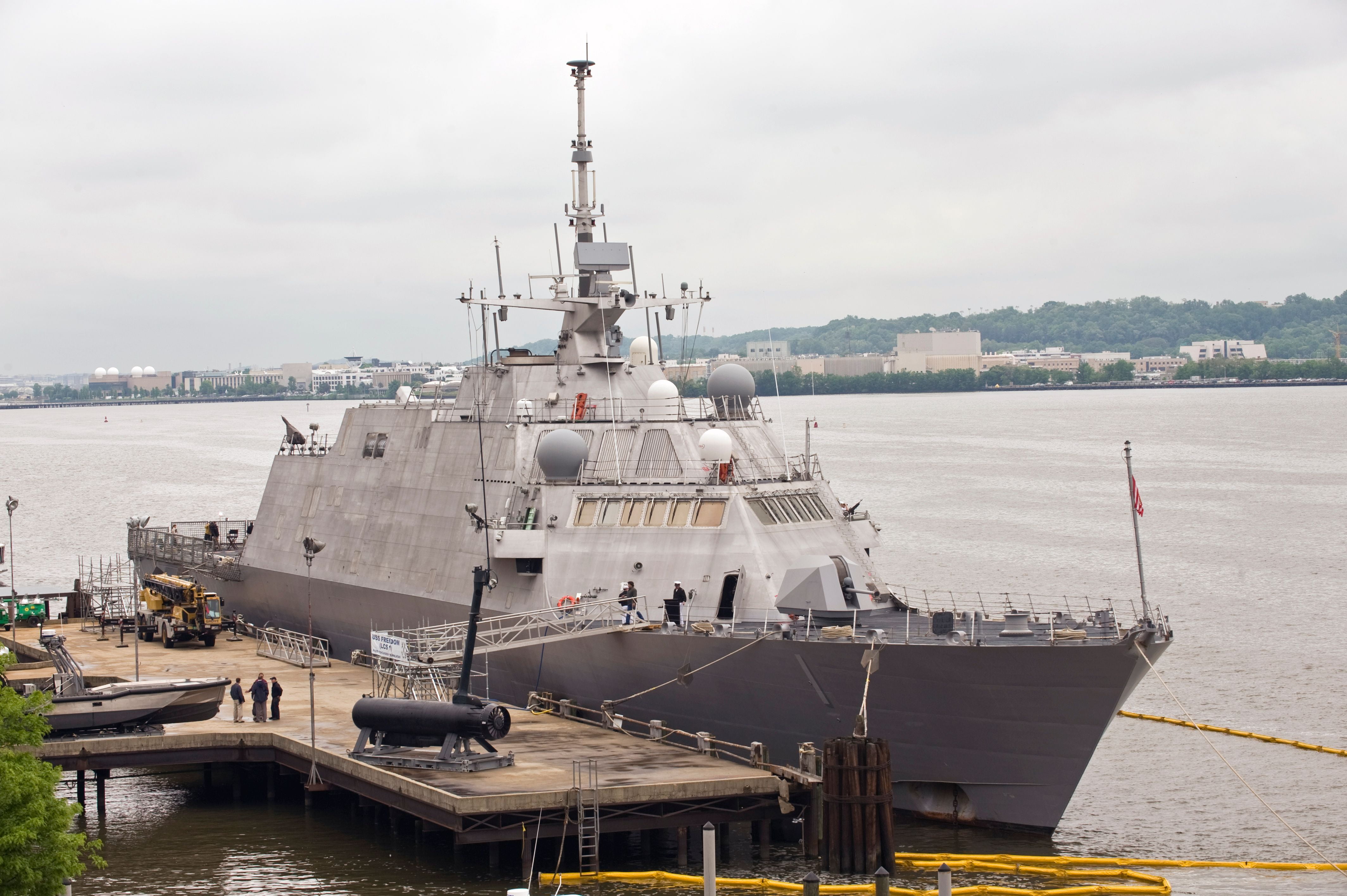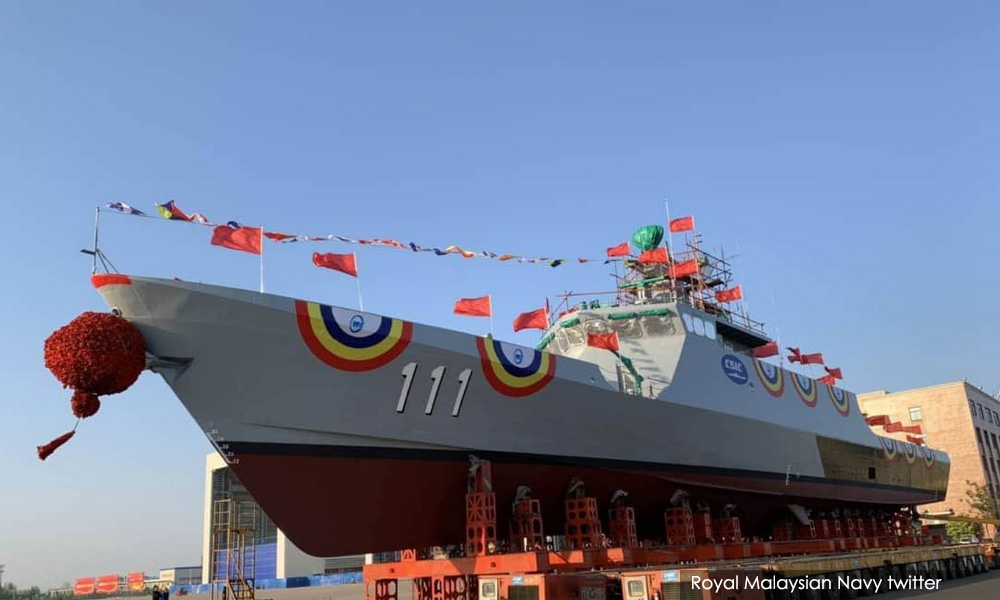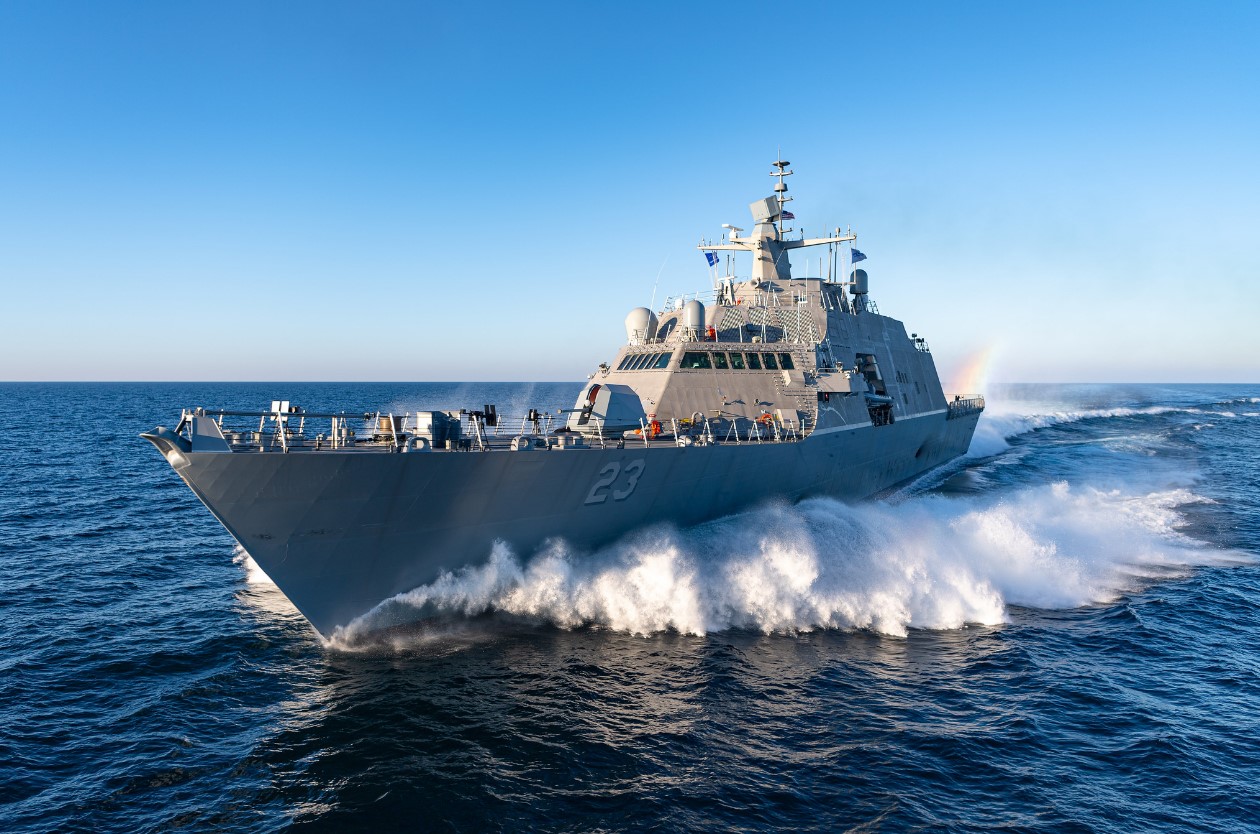Ships were built to launch the Navy into the future.
Instead, they broke down across the globe.
Many of their weapons never worked.
Now the Navy is getting rid of them.
Joaquin Sapien / ProPublica
(September 7, 2023) — In July 2016, warships from more than two dozen nations gathered off the coasts of Hawaii and Southern California to join the United States in the world’s largest naval exercise. The United Kingdom, Canada, Australia, Japan, South Korea and others sent hundreds of destroyers, aircraft carriers and warplanes. They streamed in long lines across the ocean, symbols of power and prestige.
The USS Freedom had its own special place within the armada. It was one of a new class of vessels known as littoral combat ships. The US Navy had billed them as technical marvels — small, fast and light, able to combat enemies at sea, hunt mines and sink submarines.
In reality, the LCS was well on the way to becoming one of the worst boondoggles in the military’s long history of buying overpriced and underperforming weapons systems. Two of the $500 million ships had suffered embarrassing breakdowns in previous months. The Freedom’s performance during the exercise, showing off its ability to destroy underwater mines, was meant to rejuvenate the ships’ record on the world stage. The ship was historically important too; it was the first LCS built, the first in the water, commissioned just eight years prior.
But like the LCS program’s reputation, the Freedom was in bad shape. Dozens of pieces of equipment on board were undergoing repairs. Training crews for the new class of ships had proven more difficult than anticipated. The sailors aboard the Freedom had not passed an exam demonstrating their ability to operate some of the ship’s most important systems.
As the day to launch approached, the pressure mounted. Top officers visited the ship repeatedly. The Freedom’s sailors understood that theirs was a “no fail mission” with “‘no appetite’ to remain in port,” according to Navy documents obtained by ProPublica.
The Freedom’s Capt. Michael Wohnhaas consulted with his officers. Despite crippling problems that had left one of the ship’s engines inoperable, he and his superiors decided the vessel could rely on its three others for the exercise.
The Freedom completed its mission, but the accomplishment proved hollow.

The USS Freedom in port.
Five days after the ship returned to port, a maintenance check revealed that the faltering engine had suffered “galloping corrosion” from saltwater during the exercise. A sailor described the engine room as “a horror show” with rust eating away at the machinery. One of the Navy’s newest ships would spend the next two years undergoing repairs at a cost of millions.
It took investigators months to unravel the mystery of the engine’s breakdown. But this much was clear at the outset: The Freedom’s collapse was another unmistakable sign that the Navy had spent billions of dollars and more than a decade on warships with rampant and crippling flaws.
The ongoing problems with the LCS have been well documented for years, in news articles, government reports and congressional hearings. Each ship ultimately cost more than twice the original estimate. Worse, they were hobbled by an array of mechanical failures and were never able to carry out the missions envisaged by their champions.
ProPublica set out to trace how ships with such obvious shortcomings received support from Navy leadership for nearly two decades. We reviewed thousands of pages of public records and tracked down naval and shipbuilding insiders involved at every stage of construction.
The Navy essentially admitted the LCS was “garbage.”
Our examination revealed new details on why the LCS never delivered on its promises. Top Navy leaders repeatedly dismissed or ignored warnings about the ships’ flaws. One Navy secretary and his allies in Congress fought to build more of the ships even as they broke down at sea and their weapons systems failed. Staunch advocates in the Navy circumvented checks meant to ensure that ships that cost billions can do what they are supposed to do.
Contractors who stood to profit spent millions lobbying Congress, whose members, in turn, fought to build more ships in their home districts than the Navy wanted. Scores of frustrated sailors recall spending more time fixing the ships than sailing them.
Our findings echo the conclusions of a half-century of internal and external critiques of America’s process for building new weapons systems. The saga of the LCS is a vivid illustration of how Congress, the Pentagon and defense contractors can work in concert — and often against the good of the taxpayers and America’s security — to spawn what President Dwight D. Eisenhower described in his farewell address as the “military industrial complex.”
“There is a lot of money flowing through this vast ecosystem, and somehow the only thing all these people can agree on is more, more, more,” said Lyle Goldstein, a former professor at the US Naval War College who is now investigating the “Costs of War” at Brown University. “Unfortunately, I just think it might be in the nature of our system.”
This year, the Defense Department asked Congress to approve a staggering $842 billion — nearly half of the federal government’s discretionary spending — to keep America safe in what the Pentagon says is an ever more perilous world. As House and Senate leaders negotiate the final number, it is unlikely they will spend much time discussing ways to prevent future debacles like the LCS.
Such a conversation would cover hundreds of billions of misspent taxpayer money on projects from nearly every branch of the military: The F-35 fighter jet, deployed by the Navy, Marines and Air Force, is more than a decade late and $183 billion over budget. The Navy’s newest aircraft carrier, the Gerald R. Ford, cost $13 billion and has yet to prove it can reliably launch planes. And the Army’s Future Combat System was largely abandoned in 2009 after the military had dedicated more than $200 billion on a battlefield intelligence network meant to link troops, tanks and robots.
The LCS program offers another clear lesson, one seen in almost every infamous procurement disaster. Once a massive project gains momentum and defense contractors begin hiring, it is politically easier to throw good money after bad.
Stopping a weapons program in its tracks means people losing work and admitting publicly that enormous sums of taxpayer money have been wasted. In the case of the LCS, it took an array of naval leaders and two consecutive defense secretaries to finally stop the program. Yet even after the Navy said it only needed 32 littoral combat ships, far fewer than the more than 50 originally planned, members of Congress forced the Pentagon to buy three more.
Former Lt. Renaldo Rodgers remembered laboring in San Diego from sunrise to sunset for months to ready the Freedom for a 2012 trial mission to San Francisco, only to have the ship break down during pretrial tests. Rodgers initially thought the futuristic ship looked like something out of “Star Trek.” But he soon learned it was no Starship Enterprise. It became the laughingstock of the waterfront, with other sailors deriding it as “Dry Dock One,” because it so rarely left port.
“It sucks,” he said. The LCS was “a missed opportunity.”

The Navy has tried to retire many of the littoral combat ships years before they reach their expected lifespan. Ships designed to last 25 years are being mothballed after seeing less than a decade of service.
In response to questions, the Navy acknowledged the LCS was not suitable for fighting peer competitors such as China. The LCS “does not provide the lethality or survivability needed in a high-end fight.”
“The Navy needs a more ready, capable, and lethal fleet more than a bigger fleet that’s less ready, less capable, and less lethal,” the statement read, saying the money would be better spent on higher-priority alternatives.
The cost of the program has gnawed at John Pendleton, who for years was a top military analyst at the Government Accountability Office and has studied the rise and fall of the LCS as closely as anyone in Washington.
Now retired, but unable to shake what he views as one of the most wasteful projects he’d encountered in his nearly 35-year career, Pendleton reviewed budgetary documents and GAO reports for ProPublica going back decades. His conclusion: The lifetime cost of the LCS class may reach $100 billion or more.
“In the end,” he said, “the taxpayers get fewer than 30 limited-survivability, single-mission ships.”
Pendleton is hardly alone in his assessment. Many regard the tortured path of the LCS as evidence of a damaging strain of hubris that runs rampant in the world of military innovation.
“It’s this zombie program phenomenon where everybody knows deep down we are going in the wrong direction,” said Dan Grazier, a former Marine Corps captain, who now works on Pentagon reform for the nonprofit Project on Government Oversight. “But because so much money is involved and so much political capital is invested, you can’t stop the train until the problems are so overwhelming that no one can feign support for it.”
The two narratives of the ship — unstoppable in Congress, imperiled at sea — intertwined alarmingly during one 10-month stretch beginning in December 2015. During that period, five of the vessels broke down across the globe, each illuminating a new set of problems and effectively proving the critics right.
The Freedom was the third ship to fail. Captured in a Navy investigation more than 600-pages long, the incident stands out as a particularly devastating and detailed example of the Navy’s plight.
The Problems With the Littoral Combat Ship
Mine-hunting Failures
Littoral combat ships were supposed to help find and destroy underwater mines, but the remote mine-hunting system often returned false alarms during testing, was unreliable, frequently broke down and was difficult for sailors to control. The Navy turned to a new form of minehunting technology, which is still under development.
Survivability
Because of the emphasis on speed, the ships were originally built in part on designs used for commercial ferries. The designs did not contain protections that could prevent the flooding of critical systems when under attack. The Pentagon weapons testing department found that the design requirements “accept the risk that the crew would have to abandon ship” in circumstances where service members on other vessels would not.
Combining Gear
The Navy traced many high-profile breakdowns of the Freedom-class littoral combat ships to a design flaw in what’s known as the combining gear, a complex mechanism that connects gas turbines and diesel engines to the propulsion shafts in order to help the vessels reach top speed.
The Anti-Submarine Warfare Package
Littoral combat ships were supposed to be equipped to hunt and destroy submarines with an interlinked package of sonar devices, helicopters and torpedoes. But the systems didn’t effectively communicate with one another, the towed sonar couldn’t function properly in the vessels’ wake and the Freedom class is considered too loud to hunt submarines. The Navy canceled that function in 2022.
Limited Endurance
The Freedom is considered a “gas hog” among Navy officers, meaning it can’t go very fast for very long without running out of fuel. This creates a logistical problem for the Navy because the ship can’t stray too far from its gas supply.
READ the rest of the article online at ProPublica.
ProPublica is a nonprofit newsroom that investigates abuses of power. Sign up to receive our biggest stories as soon as they’re published.
